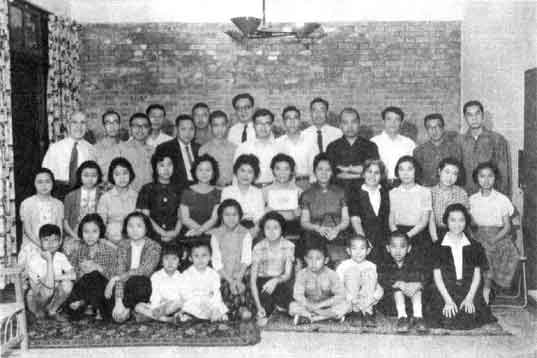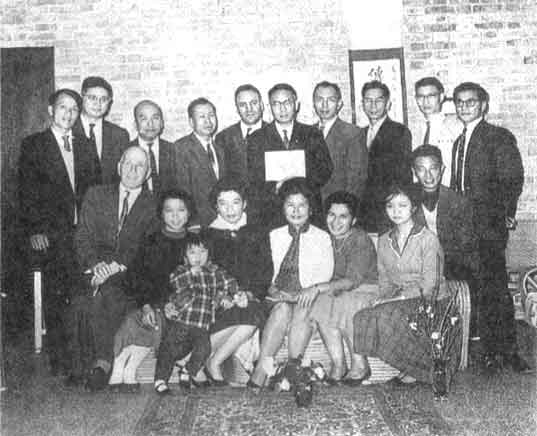
|
Taiwan Bahá'í Chronicle:
An Historical Record of the Early Days of the Bahá'í Faith in Taiwan
by Barbara R. Sims
 |
chapter 13 | start page | single page | chapter 15 |  |
Chapter 14
14. The Early 1960s and Visits of
Hands of the Cause
Miss Alexander and Dr. Muhajir
After the Summer School there was enough interest for Taipei to establish a youth group.
Travel teacher Muhammad Labib visited in 1961, with his daughter Lily, and he was successful in teaching as he was everywhere he went, causing the Local Spiritual Assembly of Taipei to write to the National Spiritual Assembly of North East Asia to send another such pioneer to Taipei. Mr. Labib, who was originally a pioneer to Japan, visited Hong Kong as well as Taiwan, but he had visa problems and could not stay for any length of time.
In 1961 Mr. Suleimani sent a list of Bahá'ís in the southern area. There were thirteen adults in Tainan, which included three women, Mrs. Tu, Mrs. Suleimani
 |
| (click for larger picture) |
The Tainan Bahá'ís and their friends celebrate Naw-Rúz 1961. Especially satisfying was to see so many young people. Mrs. Kao (Yang Su-su), newly declared, is holding the "Greatest Name".
34
In 1962 Hand of the Cause Miss Alexander visited Taiwan for the third time. Of that trip she wrote, "When we reached the Center in Tainan I could not get over my delight at the lovely Center with flowers surrounding it. I was there for eleven days, each day full. I came to know the Taiwanese people and truly loved them. Now there are quite a number of Bahá'ís in Tainan, five in one family (the Yang family) declared their faith at the same time. The last evening I met the parents for whom I felt a great love. As they were in the country under the Japanese they know the language so we could speak together. They are not Bahá'ís but their children are.
Mr. Suleimani wrote that Miss Alexander's visit was a source of inspiration to all the friends and it culminated in one declaration, Mr. Wu Pin-chen of Pingtung,
 |
| (click for larger picture) |
This photo was taken on the occasion of the Anniversary of the Birth of the Báb, October 20, 1962, at the Tainan Bahá'í Center.
Mr. Suleimani is standing at the far right. Dr. David Earl is standing in the center. Mrs. Ruthy Tu is sitting second from the left and Mrs. Suleimani is sitting second from the right.
35
Later that year one of the daughters of Mr. and Mrs. Yang, a middle school student, spoke at a picnic gathering for young people at the Bahá'í Center in Tainan. About thirty people were present to hear her speak of the history and principles of the Faith.
In April, 1962, there were one Assembly, three groups and six isolated centers. The Local Assembly of Taipei could not be formed that year due to too few members and so became a group.
With the arrival of American pioneers Dale and Barbara Enger in August 1962 activity increased in Taipei, where they settled.
Dr. Muhajir first came to Taiwan in February 1963. The next year, 1964, he came twice and in 1966 twice. He continued to visit Taiwan, for how many times it is difficult to determine. During his second trip he had meetings with the friends
 |
| (click for larger picture) |
Hand of the Cause Dr. Muhajir (standing fifth from the left) during his second visit to Taiwan, March 1964. This photo was taken at the Bahá'í Center in Tainan.
36
In April 1963 the Bahá'ís in Taiwan attempted an extensive proclamation in connection with the 100th Anniversary of the Proclamation of Bahá'u'lláh. From London, which was the site of the first World Congress, press releases were sent which were translated into Chinese and were given to all newspapers and radio stations, resulting in several newspapers publishing the information and two radio stations broadcasting it. Mr. Suleimani said it was the first time such a wide proclamation was attempted. There was a well-attended Proclamation celebration at the Tainan Bahá'í Center.
In Taipei, at the same time, there was a meeting which was reported to have had "good coverage in the Chinese newspapers."
Two days after the meeting, on April 23, the Suleimanis and Mr. Chu left Taiwan to attend the first World Congress in London. It appears that Mr. Chu might have been the only native-born Chinese to attend the Congress, although at least one Chinese-Singaporean and some Chinese-American Bahá'ís also attended.
In November 1963 two Summer Schools were held, one in Taipei and one in Tainan. The classes were conducted by the resident Bahá'ís.
One of the goals of the Ten Year Plan for India was to translate Bahá'í literature into several Chinese languages. The National Spiritual Assembly of India wrote to the National Spiritual Assembly of North East Asia asking for assistance. That Assembly then contacted the Local Spiritual Assembly of Tainan asking if they could find a way to translate any of the languages. That Assembly found a professor in a Foreign Language University who knew Mongolian (one of the languages specified), and he was able to translate The Bahá'í Message, writing it in Mongolian script, so it was ready for photo offset printing. It happened to be ready in February 1963 at a time when Dr. Muhajir was in Taiwan. As he intended to go on to India he suggested that he take it and deliver it in person to the Publishing Trust of India.
 |
chapter 13 | start page | single page | chapter 15 |  |
|
|